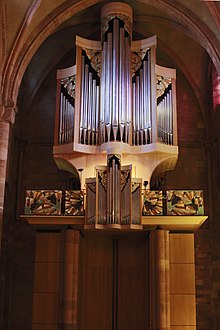Saint-Dié Cathedral
The cathedral of Saint-Dié in the southern Lorraine town of Saint-Dié-des-Vosges in the Vosges department is dedicated to St. Deodatus consecrated by St. Dié (also called Deodatus von Nevers ), an Irish-born hermit and bishop of the 7th century. The building has been recognized as a Monument historique since 1886 .
location
The cathedral is located on the northern edge of the city of Saint-Dié on the Meurthe River , a tributary of the Moselle , at an altitude of approx. 340 m .
history
As early as the 7th century, Deodatus ( French: Dieudonné ), venerated by the people as saint, is said to have founded a monastery here, from which a community of canons developed in the 10th century . At that time the church bore the patronage of St. Mauritius . The diocese of Saint-Dié was only founded in 1777 by Pope Pius VI. († 1799) erected. The church, built in different architectural styles, was blown up by the Germans in 1944, and the entire nave and the choir area including their vaults were destroyed. The reconstruction lasted until 1974; that year the church was consecrated anew . Most of the stained glass windows were made and inserted in the 1980s.
architecture
The cathedral is built from the reddish sandstone of the Vosges, from which the Strasbourg Cathedral was built. The three-aisled nave with the two-storey central nave still bears late Romanesque features, whereas the choir and the ribbed central nave vault were renewed in Gothic style as early as the 13th century ; side buttresses were added to this. The side aisles have only simple groin vaults . The transept (transept) was re-built several years later. The extremely wide and representative facade with its side bell towers (clochers) was built in the classicism style in the years 1711-14 under the direction of the Italian architect Giovanni Betto, who had previously created the facade of the cathedral of Nancy .
Furnishing
The furnishings include a few medieval glass windows (vitraux) from the late 13th century, which had already been removed and relocated at the beginning of World War II. A statue of the Mother of God with Child (Notre-Dame de Galilée) is attributed to the beginning of the 14th century. A late Gothic tomb dates back to 1369. On the south wall of the choir there is a fresco showing the presentation of a charter by Pope Leo IX. pointing to the canons of the Church. Most of the stained glass windows in the church are by Jean René Bazaine (1904–2001).
Cloister
Originally from the 15th and 16th century cloister (cloître) forms a connection between the cathedral and also worth seeing neighboring church Notre-Dame de Galilée .
organ
The organ was built in 2008–2009 by the organ builder Pascal Quoirin . The instrument has 41 stops on three manual works and a pedal. The actions are electromechanical.
|
|
|
|
|||||||||||||||||||||||||||||||||||||||||||||||||||||||||||||||||||||||||||||||||||||||
See also
literature
- Raphaël Tassin: La cathédrale de Saint-Dié-des-Vosges. Histoire, architecture et décor de l'ensemble cathédral. Serge Domini éd. 2016, ISBN 978-2354750794 .
Individual evidence
- ↑ Saint-Dié Cathedral
- ↑ Information about the organ on the website of the builder company
Web links
Coordinates: 48 ° 17 ′ 21 ″ N , 6 ° 57 ′ 2 ″ E





